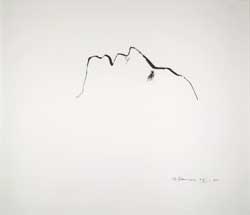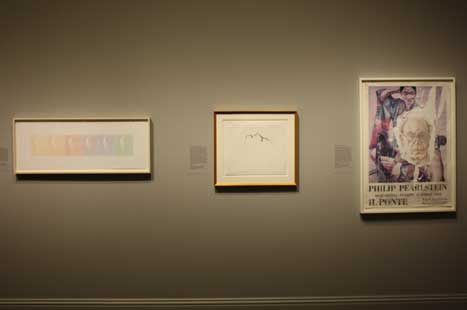The Body Art of Bruce Nauman

This article is written by Mike Maizels, a graduate student at the University of Virginia who is interning at the National Portrait Gallery. He writes about this 1990 self-portrait etching by Bruce Nauman, on display in the “Reflections/Refractions” exhibition.
A few lines. That is all Bruce Nauman seems to have given us here. When I toured “Reflections/Refractions: Self-Portraiture in the Twentieth Century” (on view at the National Portrait Gallery until August 16), I was struck by the sparseness of Nauman’s work, especially given the richness of its neighbors’. Hans Hofmann gives us a heavily worked over ink drawing that seems to testify to his immense energy. Chuck Close lets us literally see his fingerprints in his work, imparting a sense of his physical as well as visual presence. Robert Rauschenberg even offers us a monumental three part self-portrait that includes personal photos and an abbreviated, written autobiography. But Bruce Nauman gives us only a few lines.
But they are a strange few lines—they seem capable of making us move. I remember very clearly what I did when I first saw this piece. I tilted my head sideways and up, and then opened my mouth slightly, trying to place myself into that ambiguous gesture and figure out what on earth was going on. (I watched my father do the same thing, without prompting, when he saw the show.) I would argue, in all seriousness, that this turning-your-head-sideways-and-up-ness is the key to understanding not just this individual piece, but Nauman’s work as a whole (which just won the Golden Lion at the Venice Biennale, perhaps the most prestigious award in the international art world).
When his career was taking off in the 1970s, Nauman spoke emphatically about one of the most important goals of his practice. He wanted to use the human body as an art medium. As he writes, “If you can manipulate clay and end up with art, you can manipulate yourself in it as well. It has to do with using the body as a tool, an object to manipulate.” And as Nauman alludes here, whose body he is interested in is an open-ended question. He starts off, in his career and in his quotation, making art out of his own body (performance pieces, films of his body, casts of his body parts). But as his career developed, he began wanting to make art out of the viewer’s body—out of your body.
For me, the turning-your-head-sideways-and-up-ness of this piece encapsulates the core Nauman’s bodily art-making. The artist makes a symbolic gesture with his body (drawing a profile, creating a series of confining corridors, filming his tongue in slow motion) and the viewer follows with a reflexive, equally corporal response. Artist moves and viewers counter-move in a duet mediated by the physical work, which is usually quite sparse. The dance, however, is often extremely rich.
